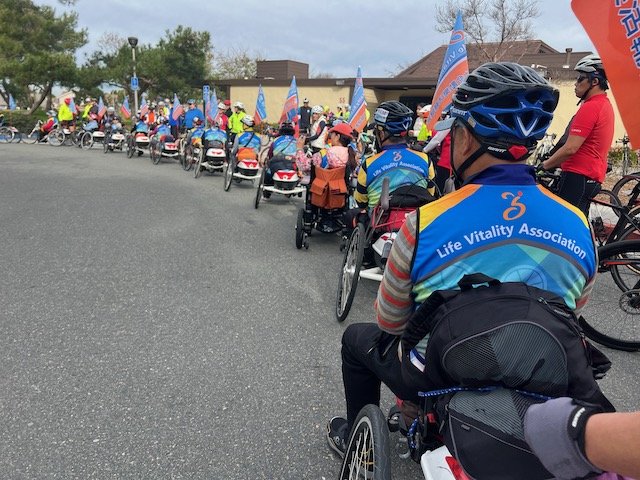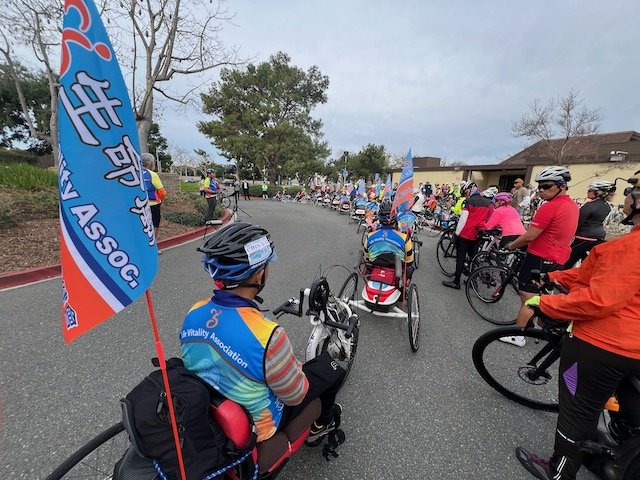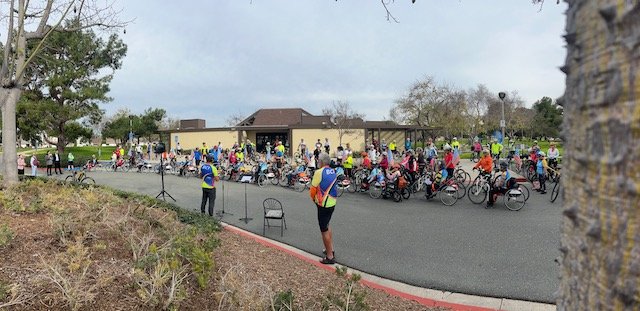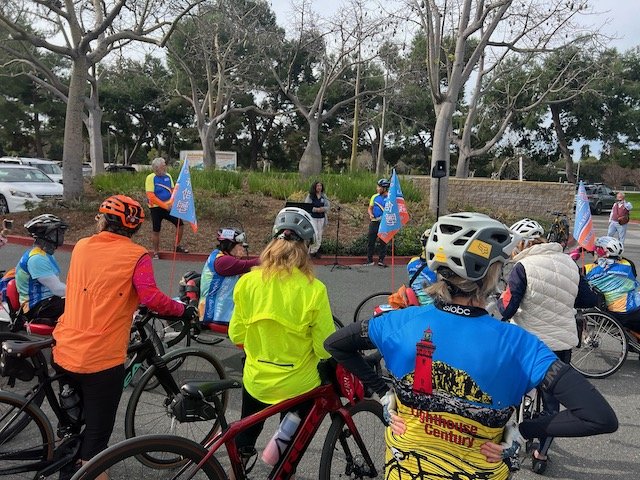Bill Sellin, BCI Ride Coordinator and also serving on the
Infrastructure Review Committee of the Orange County Bicycle Coalition
and as the Area Director of CABO for Caltrans District 12,
The California Highway Design Manual defines the Class II Bikeway (Bike Lane).
“Provides a striped lane for one-way bike travel on a street or highway.”
CA HDM, Chapter 60, Topic 62.1(2)
They are NOT obstructed with any barrier or divider from traffic lanes - there is no such thing in California as a “Protected Bike Lane” - those are Class IV separated Cycle Tracks.
Pavement MARKING Bike Lanes are marked with a standardized symbol and directional arrow. Below is the current ‘Best Practice” Complete Streets format suggested by the Department of Transportation. The helmeted bicyclist symbol (facing traffic not the gutter), and a directional arrow reminding that they are one-way and usually with traffic, and on a green background to be highlighted even when no cyclist is present.
This is the best choice of the 3 standard options:
A is a bicycle symbol, B is the bicycle rider with helmet and C is BIKE LANE in english
The National MUTCD has deleted Option B - The CA MUTCD may also drop it in the 2026 Revisions to match the National Standards...
No longer supported by the MUTCD
(National or California)
In Irvine, we don’t see the green backing yet, and still see some bike lanes marked with the 1970s standard “BIKE ONLY” - which was rejected across California as it dissuaded motorists from using Bike Lanes as they should to turn right from. Motorists are legally required to merge into the bike lane before turning right to avoid the common right hook crash. This is true in every state but Oregon. Large vehicles can’t pull this off, so always watch wide turning trucks…and some places the bike lane is way less than the 6 foot minimum on streets over 40 mph so it just won’t work (ie University WB to Culver NB). The Orange County Highway Design Manual calls for 10 to 8 foot bike lanes. The State minimum is 4 feet at 40 mph or less, 5 feet with a gutter & curb, with 3 feet between the stripe and the edge of the pavement & gutter pan, or 6 feet when the speed of traffic is over 40 mph.
We also see BIKE LANE in some places, and in some locations where a contractor uses the incorrect direction of the Fig. B marking: facing the gutter. That WAS standard in the MUTCD from 2003 to 2010, but no longer.
SIGNS Bike Lanes have a special sign: A white sign means it is regulatory and has laws in the CVC about it. That is why California has it’s own white BIKE LANE sign designated R81 (CA) which is different from the Federal standard R3-17 with a black background:
In most places, parking is not allowed in a bike lane, so there are also special R7-9 signs to remind motorists who might look to park there.
WIDTH and STRIPING Bike Lanes are only helpful when they are wide enough to ride in. Typically a cyclist needs 4 feet of operational space to ride. California standards call for a MINIMUM 4 foot wide Bike Lane except adjacent to on street parking - then a minimum of 5 feet, or when posted speed limit is over 40 mph then a minimum of 6 feet. When there is a concrete curb & gutter, the minimum width is 3 feet from the bike lane stripe to the joint between the pavenet and gutter pan - both so we won’t clip a pedal on the raised curb and also to reduce the need to ride in the gutter. The joint between the asphalt road surface and the concrete gutter pan of a standard curb can be a lateral hazard and gaps or uneven surfaces there can cause a crash.
”As grades increase, downhill bicycle speeds can increase, which increases the width needed for the comfort of bicycle operation. If bicycle lanes are to be marked, additional bike lane width is recommended to accommodate these higher bicycle speeds.”
Highway Design Manual, Chapter 300, Topic 301.2 (1)
The Orange County Highway Designs Manual calls for typically 8 foot bike lanes. 11 feet with parking. Additional width when prevailing traffic speeds are over 40 mph. They can be as narrow as 5 feet if being added to an existing roadway.
Orange County Highway Design Manual, Chapter 1000, § 1003.2 (1)
Orange County Traffic Manual, Chapter XIII, B.3
The WHITE STRIPE between the Bike Lane and Traffic Lane is 6” wide. When solid, the line is described as “Detail 39” and it is OUTSIDE of the Bike Lane width. A ‘buffer’ is when a double white strip is put down. The minimum buffer of 18” means two 6” stripes plus a 4” gap = 18”. Buffers serve to highlight motorists to stay clear of the bike lane, and provide a bit of space to pass slower cyclists or avoid debris without having to merge all the way out into th traffic lane. A buffered Bike Lane is sometimes referred to as a “BBL” or “Class 2B”.
The lane line stripe is dashed before an intersection where it is required for turning traffic to merge over & turn from the Bike Lane. When dashed, this is called a Bike Lane Intersection Line and described as “Detail 39A”. This portion of a Bike Lane is called “shared”. The standard is a 4 foot dash with 8 foot gaps. With short blocks less than 40 feet the dashed line is the minimum of 50 feet. On longer blocks or with traffic speeds of over 35 mph, the length of dashed stripe should be 200 feet. Vehicles are required to merge into the shared Bike Lane at these points. They are NOT allowed to drive in the Bike Lane before the dashed line. As Complete Streets green paint is rolled out, we will se many of these shared segments striped with green 4 foot wide blocks to the right of the white dash, with 8 foot gaps. As experienced cyclists - we know to merge out of the shared lane when the intersection line starts - or sooner if traffic permits - for 2 important reasons: 1 - Safety; by signalling and safely merging out into the traffic lane we are most visible to motorists. We control the lane and keep them from right hooking across us. We give them space to do the right thing and merge into the shared bike lane to make a right turn. 2 - Courtesy; By freeing up the shared bike lane for right turning traffic, we help motorists and other road users , have the space to turn right as required without having to wait for us to go straight. Legally we can stay in the shared bike lane, but that invites right hook overtaking by impatient traffic and holds up others who may more patiently wait behind us to make their right turn. If a motorist is doing it right, taking the shared bike lane with blinker on, scanning traffic before turning - DO NOT ‘filter up & squeeze past them in the gutter!
CA MUTCD 2023 revision, Page 1395 §20 & 21
“FILTERING UP” is the dangerous habit of passing slowing vehicles on their right, when any one of them might start to move & turn right without blinker or warning, or turn from the traffic lane instead of the shared bike lane. It is illegal to pass on the right. You are coming up on the driver’s blind side. Large vehicles can not turn from the shared bike lane and WILL turn right from the traffic lane, right hooking you. Many cyclists have been killed ‘filtering up’ on the right of moving vehicles. It also means if you come to a stop, you are now blocking the right turn option of other road users - including cyclists, who want to turn right, as they should, from the shared bike lane.
AT RIGHT TURN ONLY LANES Bike Lanes have 3 options:
1: The Bike Lane will END and we are expected to shoose the traffic lane going in our direction; Either stay to the right and use the right turn only lane (RTOL), or merge left to the through traffic lane. When the Bike Lane is ending, signal and safely merge out as early as traffic will allow.
2: The Bike Lane will be extended left of the RTOL and you will be expected to safely weave left in the conflict zone across traffic that is weaving right to the RTOL. More of these are getting Complete Streets green treatment to highlight the conflict zone. Again, either stay to the right and use the RTOL, or merge left to the extended Bike Lane. When the Bike Lane weaves left, signal and safely merge out as traffic will allow. There may be a R40-4 sign supporting the weave that tells traffic to BEGIN RIGHT TURN LANE ~ YIELD TO BIKES but always check and expect traffic to not see you.
3: In some places, the bike lane ends - maybe even with a conflict marking - into the RTOL. The sign that says RIGHT TURN ONLY may have a R118 (CA) sign added that authorizes you to stay in the RTOL even though you ar egoing straight. There may also be Sharrows painted near each right turn arrow on the pavement which authorizes ignoring the right turn controls and going straight. With out the sign or the sharrow, see #1 - it is illegal to proceed straight from a RTOL.
To go straight at a RTOL, take the green path of travel. To turn right, control the RTOL and turn right.
MANDATORY USE Using Bike Lanes is required by law, but with many exceptions including if we are moving as fast as the normal speed of traffic at that time…
California Vehicle Code 21208
(a) Whenever a bicycle lane has been established on a roadway pursuant to Section 21207, any person operating a bicycle upon the roadway at a speed less than the normal speed of traffic moving in the same direction at that time shall ride within the bicycle lane, except that the person may move out of the lane under any of the following situations:
(1) When overtaking and passing another bicycle, vehicle, or pedestrian within the lane or about to enter the lane if the overtaking and passing cannot be done safely within the lane.
(2) When preparing for a left turn at an intersection or into a private road or driveway.
(3) When reasonably necessary to leave the bicycle lane to avoid debris or other hazardous conditions.
(4) When approaching a place where a right turn is authorized.
Including every driveway!
(b) No person operating a bicycle shall leave a bicycle lane until the movement can be made with reasonable safety and then only after giving an appropriate signal in the manner provided in Chapter 6 (commencing with Section 22100) in the event that any vehicle may be affected by the movement.
WE should to signal and yield as we merge out of a Bike Lane to the traffic lane.
























































